Pissoir
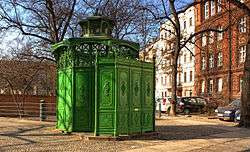
A pissoir or vespasienne is a structure that provides support and screening of urinals in public space. It is a French invention common in Europe that allows for urination in public without the need for a toilet building. The availability of pissoirs is likely to reduce urination onto buildings, sidewalks, or streets.[1]
History
In the spring of 1830 the city government of Paris decided to install the first public urinals on the major boulevards. These structures served both as urinals and supports for posters and advertising. They were put in place by the summer, but in July they were put to a completely different purpose; providing materials for street barricades during the French Revolution of 1830.[2]
They were re-introduced in different form in Paris in 1841 by Claude-Philibert Barthelot, comte de Rambuteau, the Préfet of the former Départment of the Seine. Initially having a simple cylindrical shape, they were also called colonnes Rambuteau. In 1877 they were replaced by multi-compartmented structures called vespasiennes,[3] in reference to the 1st-century Roman emperor Titus Flavius Vespasianus, who placed a tax on urine collected from public toilets for use in tanning. At the peak of their spread in the 1930s there were 1,230 pissoirs in Paris, but by 1966 their number had decreased to 329. By 2006 only one remained, on Boulevard Arago.[4] (From 1981 they had been replaced systematically with new technology, the Sanisette.)[5]
In Berlin the first pissoirs were erected in 1863. In order to distinguish them from those of other cities, several architectural design competitions were organised in 1847, 1865 and 1877. One of the most successful types was an octagonal structure with seven stalls, first built in 1879. Their number increased to 142 by 1920.[6]
Temporary pissoirs with multiple unscreened urinals around a central column have been introduced in the UK.[7][8] A temporary pissoir for women called the Peeasy is used in Switzerland.[9]
In popular culture
A pissoir was featured in the first scene of the 1967 James Bond spoof film Casino Royale.[1]
Plaskruis
A plaskruis is a pissoir that is the same size as a portable toilet and provides four urinals per unit. They are not connected to the sewer system but have their own storage tank. They are commonly used for music festivals and other events, but some cities also use them on a regular basis to control public urination during busy nights. It was designed by Joost Carlier who works for Lowlands and other events. They were first used in 1991 during the "Monsters Of Rock" event in the Goffertpark.
| Wikimedia Commons has media related to plaskruis. |
Gallery
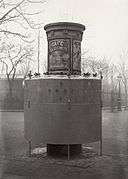 Single stall cylindrical urinal, Paris, ca.1865
Single stall cylindrical urinal, Paris, ca.1865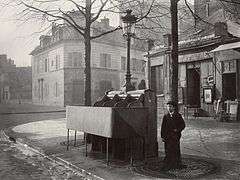 A pissoir with three stalls, Paris, ca.1865
A pissoir with three stalls, Paris, ca.1865 Elevation, section and plan drawings of an octagonal pissoir in Berlin, 1896
Elevation, section and plan drawings of an octagonal pissoir in Berlin, 1896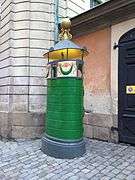 A pissoir close to the royal castle in Gamla Stan, Stockholm, Sweden, 2014
A pissoir close to the royal castle in Gamla Stan, Stockholm, Sweden, 2014%2C_2011%2C_Urinol._(5925305117).jpg) Pissoir in Lisbon
Pissoir in Lisbon Pissoir in Copenhagen
Pissoir in Copenhagen A retractable pissoir in The Hague
A retractable pissoir in The Hague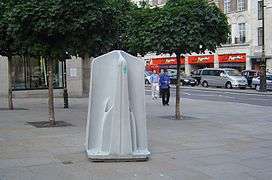 Plaskruis in London
Plaskruis in London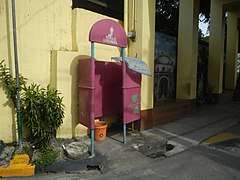 MMDA Street Urinal in Pateros, Metro Manila, Philippines
MMDA Street Urinal in Pateros, Metro Manila, Philippines
Bibliography
- Fierro, Alfred (1996). Histoire et dictionnaire de Paris. Robert Laffont. ISBN 2-221-07862-4.
Notes
- 1 2 Jaggard, David (27 March 2012). "The Flow of History: The Mercifully Dwindling Presence of the Parisian Pissoir". Paris Update. Retrieved 18 July 2016.
- ↑ Fierro 1996, p. 1177.
- ↑ Pike, David L. (2005): Subterranean Cities: The World Beneath Paris and London, 1800-1945, Cornell University Press
- ↑ Ress, Paul (2006): Shaggy Dog Tales: 58 1/2 Years of Reportage, Xlibris
- ↑ Bärthel, Hilmar (2000): "Tempel aus Gusseisen: Urinale, Café Achteck und Vollanstalten", Berlinische Monatsschrift Heft 11
- ↑ "The Pee Pod - the place to pee in Milton Keynes!". BBC news, 15 June 2010.
- ↑ "Edinburgh to trial 'pee pod' street urinals". BBC news, 24 November 2010.
- ↑ Salzmann, Claudia. "Frauen-Pissoir: Kein leichtes Unterfangen". Berner Zeitung, 18 July 2011 (in German).
External links
